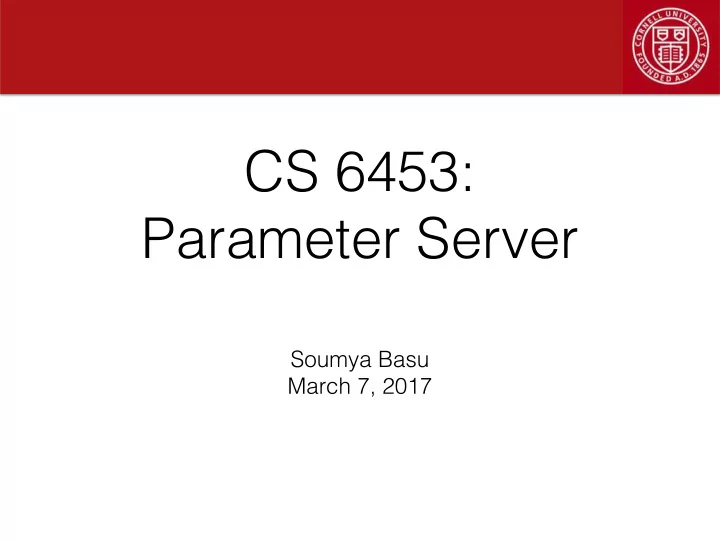

CS 6453: Parameter Server Soumya Basu March 7, 2017
What is a Parameter Server? • Server for large scale machine learning problems • Machine learning tasks in a nutshell: Feature (1, 1, 1) Training Extraction (2, -1, 3) (5, 6, 7) … • Design a server that makes the above fast!
Why Now? • Machine learning is important! • Read the news to see why… • Feature extraction fits nicely into Map-Reduce • Many systems take care of this problem… • So, parameter server focuses on training models
Training in ML • Training consists of the following steps: 1. Initialize model with small random values 2. Try to guess the right answer for your input set 3. Adjust the model 4. Repeat step 2-3 until your error is small enough
Systems view of Training • Initialize model with small random values • Paid once- fairly trivial to parallelize • Try to guess the right answer for your input set • Iterate through the input set many many times • Adjust the model • Send a small update to the model parameters
Key Challenges • Three main challenges of implementing a parameter server: • Accessing parameters requires lots of network bandwidth • Training is sequential and synchronization is hard to scale • Fault tolerance at scale (~25% failure rate for 10k machine-hour jobs)
First Attempts • First attempts used memcached for synchronization [VLDB 2010] • Key-value stores have very large overheads • Synchronization costs are expensive and not always necessary
Second Generation • Second generation of attempts were application specific parameter servers [WDSM 2012, NIPS 2012, NIPS 2013] • Fails to factor out common difficulties between many different types of problems • Difficult to deploy multiple algorithms in parallel
General Purpose ML • General purpose machine-learning frameworks • Many have synchronization points -> difficult to scale • Key observation: cache state between iterations
GraphLab • Distributed GraphLab [PVLDB 2012] • Uses coarse-grained snapshots for fault tolerance, impeding scalability • Doesn’t scale elastically like map-reduce frameworks • Asynchronous task scheduling is the main contribution
Piccolo • Piccolo [OSDI 2010] • Most similar to this paper • Is not optimized for Machine Learning though
Technical Contribution • Recall the three main challenges: • Accessing parameters requires lots of network bandwidth • Training is sequential and synchronization is hard to scale • Fault tolerance at scale
Dealing with Parameters • What are parameters of a ML model? • Usually an element of a vector, matrix, etc. • Need to do lots of linear algebra operations • Introduce new constraint: ordered keys • Typically some index into a linear algebra structure
Dealing with Parameters • What are parameters of a ML model? • Usually an element of a vector, matrix, etc. • Need to do lots of linear algebra operations • Introduce new constraint: ordered keys • Typically some index into a linear algebra structure
Dealing with Parameters • High model complexity leads to overfitting • Updates don’t touch many parameters • Range push-and-pull: Can update a range of values in a row instead of single key • When sending ranges, use compression
Synchronization • ML models try to find a good local min/min • Need updates to be generally in the right direction • Not important to have strong consistency guarantees all the time • Parameter server introduces Bounded Delay
Fault Tolerance • Server stores all state, workers are stateless • However, workers cache state across iterations • Keys are replicated for fault tolerance • Jobs are rerun if a worker fails
Evaluation
Evaluation
Limitations • Evaluation was done on specially designed ML algorithms • Distributed regression and distributed gradient descent • How fast is it on a sequential algorithm? • Count-Min Sketch is trivially parallelizable • No neural networks evaluated?
Future Work • What happens to sequential ML algorithms? • Synchronization cost ignored, rather than resolved • Where are the bottlenecks of synchronization? • Lots of waiting time, but on what resource(s)?
Recommend
More recommend